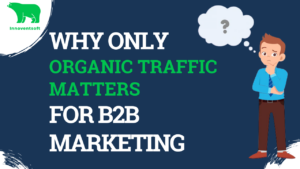Someone rightly said, “‘Skip ad’ could be the highest performing CTA.”
I believe there’s some truth to it. Ads are not working like they did before, and B2B organizations rely less on paid media channels and focus more on organic traffic to generate leads.
There’s no doubt that quality content aimed at different buyer’s journey stages can help bring organic traffic and create a healthy sales pipeline. But many don’t know the fundamentals of B2B content marketing, like how to create content that connects with the prospects and leads them to become customers.
In this piece, we’ll look at four steps B2B companies can use to create engaging content, measure its impact, and build a system so that they can optimize the traffic to generate more revenue.
Step #1: Defining your target personas
If you’re creating content for everyone, then your content is for no one.
It’s just like how your product wouldn’t suit every company in the world. There are ideal customer personas (ICPs) you want to target and sell your product to. And figuring out ICPs are complex in a B2B selling scenario since B2B selling is complex.
Unlike B2C, there are different layers of stakeholders in a typical B2B buying process. You’ll need approvals from everyone, and that’s why the sales cycle is normally long in B2B. However, we can simplify and categorize the stakeholders into three:
- Buyers
- Influencers
- Users

These three groups are your audience, and you should create content for every one of them. We’ve covered all three groups in detail here: 4 Steps to Create an Effective Content Calendar for B2B Organizations.
Once you’ve identified who your target audience is, it’s time to create content for them.
Step #2: Creating content for the customer lifecycle journey
To create content, you need to know the pain points or concerns of your target audience. But the problem is, they change as the prospects move down the sales funnel, which makes it hard for content or product marketers to create content aiming for all of them.
In fact, creating content that appeals to different stages of the buyer’s journey is one of the most common challenges for content marketers, as per Content Marketing Institute (CMI) insights 2023 report. Out of all the participants in the survey, 60% of them struggle to create buyer’s-journey targeted content.

Typically, content marketers use the AIDA framework to track the lifecycle journey of customers as they move from awareness and consideration to the decision stage. Innoventsoft has come up with an updated model of AIDA, called AIDA++ (refer to the image below), which you can use so that your content resonates with the target audience in their respective buying lifecycle stages.
The eight stages of the AIDA++ framework are,
- Awareness
- Interest for research
- Interest for comparison
- Desire to purchase
- Act and use
- Experience
- Loyalty
- Word of mouth

Here’s an in-depth look into the AIDA++ model for B2B marketers: Understanding B2B Customer Lifecycle Journey for Content Strategy
You can also automate creating content depending on the lifecycle stages of the buyer’s journey using Innoventsoft’s ICM platform. Using AI/ML predictions, you could get a content map spanning different stages of the buyer’s journey in a matter of a few clicks.
Understanding the lifecycle stages of prospects follows writing content, which begs the question: Who should write content? Product marketers or content marketers?
Normally, content marketers focus on top-of-the-funnel articles, to increase brand awareness and attract people to the funnel. The content wouldn’t be leaning on the product they sell but around common topics surrounding the domain.
Meanwhile, product marketers write content around the product/solution and lead prospects to buy. The content helps prospects understand the value proposition and the benefits of using the product. The goal of the content would then be to generate more marketing-qualified leads (MQLs) and increase sales.
Whoever writes the content, knowing how to write quality content is essential to get more leads out of the traffic. The good thing is that you can learn how to write good content by following these nine rules:
- Set a goal
- Do a lot of research
- Outline first, then write
- Give it a personal touch
- Write for your customers
- Embrace TUFD
- Make it trustworthy
- Give a catchy headline
- Add actionable tips while concluding
Follow the link to learn more about each step and craft quality content your readers crave: 9 Golden Rules for Effective Content Writing.
By now, you’ve identified your audience, understand their pain points depending on where they are in the sales funnel, and created content for them. Now it’s time to measure the effectiveness of content creation workflow and the impact of the content on the brand and revenue.
Step #3: Measuring content impact on sales
As a B2B content marketer or product marketer, you’ll need to make decisions frequently to optimize your strategies for better results. You’ll want to ensure maximum output from the effort distribution, which can be hard to do without proper data. This brings the question: What should you measure? And how do you measure? It’s a persistent problem most marketers struggle with.
In the report from CMI, 43% of marketers find it hard to develop consistency with measurements.

However, you can mitigate this by narrowing your focus to two things that are key to content: content creation and impact.
You would want to know how the content creation workflow going to ensure no bottlenecks are sabotaging the process. Similarly, unless you know how content is affecting organizational-level goals and bringing revenue, it would be hard to justify marketing spending on content to stakeholders.
You can measure content workflow and its impact by setting what we call “the six golden metrics.” There are two operation metrics and four business metrics that will give you a holistic view of content and help you optimize for better ROI. Follow the link to explore them: 6 Golden Metrics to Track the Impact of Product Marketing on Business.

Also, you may check out the ICM platform to track the metrics live. The platform can be your go-to centralized tool to create a content map and monitor its impact on revenue.
Step #4: Creating a system
Now that you’ve created content and understand how it’s contributing to the sales pipeline and revenue generation, you’d want to create a system to make it repeatable and scalable. This is where a content calendar comes into play.
A content calendar includes the list of content you’ll publish in a certain period. Depending on your domain, your content cadence will differ and you can plan them using a content calendar. It will give you enough time to work on a topic with a deadline in mind.
Once you create enough content, you can measure the impact using the metrics shared above and optimize the process if needed.
Learn how to create a content calendar and fill it up with content topics that matter to produce good quality content that makes prospects convert: 4 Steps to Create an Effective Content Calendar for B2B Organizations.
Create quality content using Innoventsoft platform
When most B2B organizations rely on reactive content generation, play the long game of producing quality content for different buyer journeys. The focus should be on providing maximum value to the prospects so that they move further down the funnel and see you as a trustworthy source of information. Providing a unifying experience like that would give you a greater ROI than most marketing tactics out there.
To do this faster and make quick decisions along the way, you’d need smart tools like the ICM platform. With the tool, you’d always have a bird’s-eye view of content generation and its impact on various business metrics.
We’ve already helped companies who were struggling with generating leads and increasing organic traffic to their blogs (read the case studies here). If you’d like to increase the number of MQLs and create a healthy sales pipeline to generate more revenue, check out the ICM platform and request a free trial.





